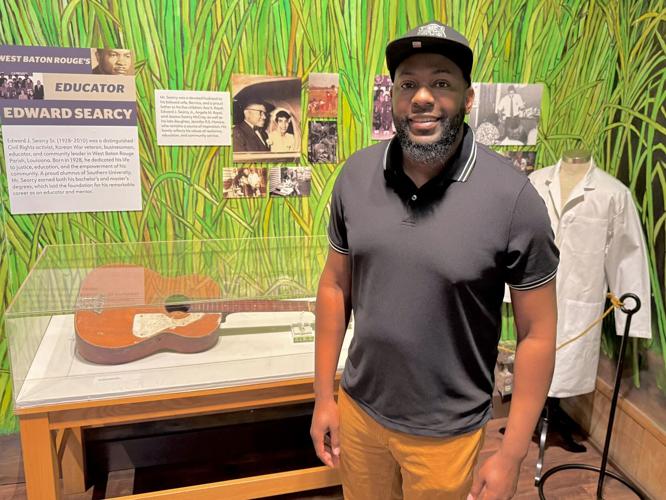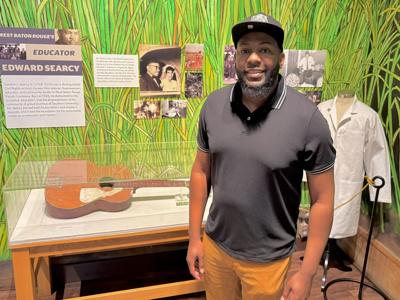Shelton Berry first encountered Edward Searcy while exiting Port Allen High School's band room.
Berry doesn't remember the exact date, only that he was a student dressed to the nines for a school function. Was he in the ninth grade or 10th? He doesn't remember.
But he does recall thinking he looked pretty good in his suit until Searcy set him straight.

The West Baton Rouge Museum's exhibit, 'West Baton Rouge's Educator: Edward Searcy,' begins with the same lab coat he wears in this photo, when he was a biology teacher at Port Allen High School. The museum will host a 'school reunion' reception in celebration of Searcy's life on May 16.Â
"I had on some dress shoes, and (Searcy) said, 'Young, man, come here,'" Berry said. "So I walked over, and he stuck out his hand for me to shake it. He said, 'Edward Searcy. Next time I see you, I want those shoes clean. You understand, sir?' And I said, 'Yes, sir.'"
A local legend
Even then, Berry knew he had come face to face with a local legend. Searcy had taught biology to their grandparents, parents and with any luck would also one day teach the next generation.Â
Searcy was known for his civil rights activism in the community, lifelong military service and the Boston marathons completed along the way.

Angela Searcy Royal, left, and Ava Searcy Royal, two of Edward Searcy's children, stand in front of a display commemorating their father's military service and his Boston Marathon participation in the West Baton Rouge Museum's exhibit, West Baton Rouge's Educator: Edward Searcy.'
Berry eventually would take Searcy's biology class, but on this particular day, the teacher taught the band kid a valuable life lesson: Presentation isn't about making a fashion statement. It's about presenting your best self to the world at all times.
Attention to detail is a part of that presentation, and Searcy knew it.
"He was always wearing a lab coat and polished shoes," Berry said.

A portrait of Edward Searcy taken in his younger days. Searcy was an educator and social activist in West Baton Rouge Parish and is considered a local legend. Â
A planned 'school reunion'
That same lab coat now stands in a corner in the West Baton Rouge Museum's Perkins Gallery as part of the exhibit, "West Baton Rouge's Educator: Edward Searcy." The show runs through May 25, but the museum, 845 N. Jefferson Ave., Port Allen, is hosting a "school reunion" reception from 6 p.m. to 8 p.m. on May 16, where former students from Cohn and Port Allen high schools, fellow teachers and everyone else who knew him can reunite to share memories about their favorite teacher.
For those who didn't know Searcy, the show is a chance to learn about the man who influenced so many people in West Baton Rouge Parish.
Berry is the curator of this show, which occupies three corners of the museum's Perkins Gallery. And though it seems small, its photos and artifacts pack a powerful punch.

Edward Searcy and his wife, Bernice, on their wedding day. The West Baton Rouge Museum is planning a 'school reunion' reception on May 16 to coincide with its exhibit, 'West Baton Rouge's Educator: Edward Searcy.'
The lab coat
The show begins with the lab coat. It's been starched and ironed, which isn't unusual to Searcy's daughters, Ava Searcy Royal and Angela Searcy Royal, two of Searcy's five children.
"We both married brothers," Ava Searcy Royal said.
They grew up in Searcy's Winterville home, where they remember their mother, Bernice, as the "most beautiful woman in the world," and their even-tempered father whose life lessons included getting up early each morning to work in the garden before school — which resulted in food for the supper table.

A portrait of Edward Searcy in his Navy uniform. Searcy served in the U.S. Army during the Korean War and also served in reserves for the U.S. Navy and U.S. Air Force.
The sisters were only kids at the time and remember that the work back then was a chore to them. But as adults, they see the benefits, as their dad knew they would.
"We always ate well," Angela Searcy Royal said.

Edward Searcy's jacket bearing patches from the Boston Marathon races in which he ran and completed is included in the West Baton Rouge Museum's exhibit, 'West Baton Rouge's Educator: Edward Searcy.'
A long walk
Searcy was born Sept. 19, 1928, in south Baton Rouge, but spent the majority of his life in Winterville, from where, after finishing elementary school, he often made the long walk from his house to Southern Laboratory High School, a distance of at least eight miles.Â
Cohn High had yet to be built, so there was no high school for Black students in West Baton Rouge at the time. Searcy wanted to continue his education at the best possible institution available to him.
"So, he walked, and that meant walking across the bridge," Angela Searcy Royal said. "And it was hot on a lot of those days, but he liked it hot."

A photo of Edward Searcy running the Boston Marathon is included in the West Baton Rouge Museum's exhibit, 'West Baton Rouge's Educator: Edward Searcy.' The museum is planning a 'school reunion' reception celebrating Searcy's life and service on May 16.
Later in life, Searcy would get up before sunrise on the hottest of Louisiana mornings to train for the Boston marathon. The heat also didn't bother him in his military training, which was continuous.
Military service
"He was in the U.S. Army at Fort Leonard for two years during the Korean conflict," Angela Searcy Royal said. "He was in the U.S. Army Reserve in Baton Rouge for 11 years, and he served as a Green Beret in the Special Forces for four years in Mississippi. He served in the Air Force Reserve in Belle Chasse for 11 years and the U.S. Naval Sea Cadets Corps for 15 years, where he subsequently became the commanding officer. And at the time of his death, I have a recorded tape where he requested his burial at the National Military Cemetery with the Naval Sea Cadets."
He was still qualifying to do airplane jumps even later in his life and took his daughters to watch him jump.Â

A photo of Edward Searcy leading a protest in front of the National Food Store in Port Allen after the store refused to hire Black employees. The photo is featured in the West Baton Rouge Museum's exhibit, 'West Baton Rouge's Educator: Edward Searcy.'
The sisters share so many other memories, stories of family and valuable lessons learned. They lost him to cancer in 2010. He was 81.
Civil rights leader
Still, topping all of the lessons were Searcy's actions in life, especially when it came to social activism. The educator stepped into the role of civil rights leader and helped to expand voter registration among Blacks, boycott businesses that wouldn't hire Black employees and integrate West Baton Rouge Parish's schools.
Tempers ran high and threats were made. But Searcy was not deterred, even when segregationists constructed a barbed wire fence around Devall Middle School and shot at him to keep Black students from entering.

Edward Searcy, left, and a fellow protester peacefully stand beside a counter protester outside the National Food Store in Port Allen in 1966. The photo is included in the West Baton Rouge Museum's exhibit, 'West Baton Rouge's Educator: Edward Searcy.'
"Mr. Searcy and the civil rights activists cut it down," Berry said.
He stands next to the exhibit case displaying newspaper clippings and letters documenting those days' events.
"He was very organized in everything he did," Berry said. "He didn't back down. He and the other protesters returned to tear the fence down again. He made lists of everything."

Edward Searcy's handwritten list documenting his protest at the National Food Store in Port Allen in 1966 is included in the West Baton Rouge Museum's exhibit, 'West Baton Rouge's Educator: Edward Searcy.'
Berry points to a small sheet of paper in the exhibit case. It contains a list in Searcy's meticulous handwriting, dated Nov. 23, 1966, when he and others picketed in front of the National Food Store that day.
From there comes Searcy's list:
- Started 8:20 a.m.
- Ended 6:30 p.m.
- Effectiveness: Excellent
- Approximately 20 Negroes went in across the picket line, but the majority of people respected it.
- Difficulties: None.
Change wasn't immediate, but it did come to West Baton Rouge Parish partly due to Searcy's efforts. Â

Shelton Berry, curator of the West Baton Rouge Museum's exhibit, 'West Baton Rouge's Educator: Edward Searcy,' points out the lab coat Searcy wore while teaching biology. It's the same lab coat the educator was wearing when Berry was a student in his class.
"He often talked about being out there in the cold, not having anywhere to use the bathroom, not being able to go in and grab a bite to eat," Berry said. "And he often even talked about being harassed, bullied and shot at."
All of which opened Berry's eyes as one of Searcy's students.
Searcy's directive about shining shoes really wasn't about shoes at all. It was an early lesson in professionalism and opportunity, something Searcy taught to all of his students no matter their color or ethnicity.
"He was already this legendary figure when I got into high school, and when you met him, you just knew you were meeting somebody extremely important," Berry said. "But I had no idea that he accomplished all of this, because he was so humble."












